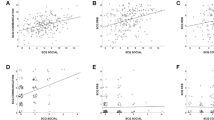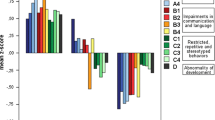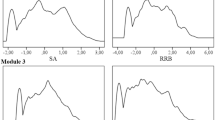Abstract
There is an ongoing debate whether a differentiation of autistic subtypes, especially between Asperger Syndrome (AS) and high-functioning-autism (HFA) is possible and if so, whether it is a categorical or dimensional one. The aim of this study was to examine the possible clustering of responses in different symptom domains without making any assumption concerning diagnostic appreciation. About 140 children and adolescents, incorporating 52 with a diagnosis of AS, 44 with HFA, 8 with atypical autism and 36 with other diagnoses, were examined. Our study does not support the thesis that autistic disorders are discrete phenotypes. On the contrary, it provides evidence that e.g. AS and autism are not qualitatively distinct disorders, but rather different quantitative manifestations of the same disorder.



Similar content being viewed by others
References
Anderson, G. M. (2008). The potential role for emergence in autism. Autism Research, 1, 18–30.
Asperger, H. (1944). Die „autistischen Psychopathen“im Kindesalter. Archiv für Psychiatrie und Nervenkrankheiten, 117, 76–136.
Baird, G., Simonoff, E., Pickles, A., Chandler, S., Loucas, T., Meldrum, D., et al. (2006). Prevalence of disorders of the autism spectrum in a population cohort of children in South Thames: The special needs and autism project (SNAP). Lancet, 368, 210–215.
Baron-Cohen, S., Scott, F. J., Allison, C., Williams, J., Bolton, P., Matthews, F. E., et al. (2009). Prevalence of autism-spectrum conditions: UK school-based population study. British Journal of Psychiatry, 194, 500–509.
Bennett, T., Szatmari, P., Bryson, S., Volden, J., Zwaigenbaum, L., Vaccarella, L., et al. (2008). Differentiating autism and asperger syndrome on the basis of language delay or impairment. Journal of Autism and Developmental Disorder, 38, 616–625.
Bölte, S., Rühl, D., Schmötzer, G., & Poustka, F. (2006). ADI-R diagnostisches interview für autismus—revidiert. Bern: Huber.
Carter, A. S., Volkmar, F. R., & Sparrow, S. S. (1998). The vineland adaptive behavior scales: Supplementary norms for individuals with autism. Journal of Autism and Developmental Disorders, 28, 287–302.
Constantino, J. N., Lajonchere, C., Lutz, M., Gray, T., Abbacchi, A., McKenna, K., et al. (2006). Autistic social impairment in the siblings of children with pervasive developmental disorders. American Journal of Psychiatry, 163, 294–296.
Constantino, J. N., & Todd, R. D. (2003). Autistic traits in the general population: A twin study. Archives of General Psychiatry, 60, 524–530.
Dawson, G., Webb, S., Schellenberg, G. D., Dager, S., Friedman, S., Aylward, E., et al. (2002). Defining the broader phenotype of autism: Genetic, brain, and behavioral perspective. Development and Psychopathology, 14, 581–611.
Fimm, B., & Zimmermann, P. (2002). Testbatterie zur Aufmerksamkeitsprüfung (TAP) (Version 1.7). Herzogenrath : Psytest.
Fombonne, E. (2009). Epidemiology of pervasive developmental disorders. Paediatric Research, 65, 591–598.
Frith, U. (2004). Emmanuel miller lecture: Confusions and controversies about asperger syndrome. Journal of Child Psychology and Psychiatry, 45, 672–686.
Gadow, K. D., DeVincent, C. J., Pomeroy, J., & Azizian, A. (2004). Psychiatric symptoms in preschool children with PDD and clinic and comparison samples. Journal of Autism and Developmental Disorders, 34, 379–393.
Gadow, K. D., DeVincent, C. J., Pomeroy, J., & Azizian, A. (2005). Comparison of DSM-IV symptoms in elementary school-aged children with PDD versus clinic and community samples. Autism, 9, 392–415.
Georgiades, S., Szatmari, P., Zwaigenbaum, L., Duku, E., Bryson, S., Roberts, W., et al. (2007). Structure of the autism symptom phenotype: A proposed multidimensional model. Journal of the American Academy of Child and Adolescent Psychiatry, 46(2), 188–196.
Gillberg, C. (1998). Asperger syndrome and high-functioning autism. British Journal of Psychiatry, 172, 200–209.
Gillberg, C., Gillberg, I. C., Rastam, M., & Wentz, E. (2001). The asperger syndrome (and high-functioning autism) diagnostic interview (ASDI): A preliminary study of a new structured clinical interview. Autism, 5, 57–66.
Howlin, P. (2000). Outcome in adult life for more able individuals with autism or Asperger syndrome. Autism, 4, 63–83.
Howlin, P. (2003). Outcome in high-functioning adults with autism with and without early language delays: Implication for the differentiation between autism and Asperger syndrome. Journal of Autism and Developmental Disorders, 33, 3–13.
Kamp-Becker, I., Ghahreman, M., Smidt, J., & Remschmidt, H. (2009). Dimensional structure of the autism phenotype: Relations between early development and current presentation. Journal of Autism and Developmental Disorder, 39, 557–571.
Klin, A., & Jones, W. (2006). Attributing social and physical meaning to ambiguous visual displays in individuals with higher-functioning autism spectrum disorders. Brain and Cognition, 61(1), 40–53.
Klin, A., Pauls, D., Schultz, R., & Volkmar, F. (2005). Three diagnostic approaches to asperger syndrome: Implications for research. Journal of Autism and Developmental Disorders, 35, 221–234.
Klin, A., Saulnier, C. A., Sparrow, S. S., Cicchetti, D. V., Volkmar, F., & Lord, C. (2007). Social and communication abilities and disabilities in higher functioning individuals with autism spectrum disorders: The vineland and the ADOS. Journal of Autism and Developmental Disorders, 37, 748–759.
Klin, A., Volkmar, F. R., & Sparrow, S. S. (2000). Introduction. In A. Klin, F. R. Volkmar, & S. S. Sparrow (Eds.), Asperger syndrome (pp. 1–21). New York: Guilford Press.
Klin, A., Volkmar, F. R., Sparrow, S. S., Cicchetti, D. V., & Rourke, B. P. (1995). Validity and neuropsychological characterization of Asperger syndrome. Journal of Child-Psychology and Psychiatry, 36, 1127–1140.
Kopra, K., von Wendt, L., Nieminen-von Wendt, T., & Paavonen, E. J. (2008). Comparison of diagnostic methods for asperger syndrome. Journal of Autism and Developmental Disorder, 38, 1567–1573.
Krueger, R. T., & Bezdjian, S. (2009). Enhancing research and treatment of mental disorders with dimensional concepts: Toward DSM-V and ICD-11. World Psychiatry, 8, 3–6.
Lord, C., Risi, S., Lambrecht, L., Cook, E. H., Leventhal, B., DiLavore, P. C., et al. (2000). The ADOS-G (autism diagnostic oberservation schedule-generic): A standard measure of social-communication deficits associated with autism spectrum disorders. Journal of Autism and Developmental Disorders, 30, 205–223.
Lotspeich, L. J., Kwon, H., Schumann, C. M., Fryer, S. L., Goodlin-Jones, B. L., Buonocore, M. H., et al. (2004). Investigation of neuroanatomical differences between autism and Asperger syndrome. Archives of General Psychiatry, 61, 291–298.
Macintosh, K. E., & Dissanayake, C. (2004). Annotation: The similarities and differences between autistic disorder and Asperger´s disorder: A review of the empirical evidence. Journal of Child Psychology and Psychiatry, 45, 421–434.
Mayes, S. D., Calhoun, S. L., & Crites, D. L. (2001). Does DSM-IV Asperger’s disorder exist? Journal of Abnormal Child Psychology, 29, 263–271.
McAlonan, G., Suckling, J., Wong, N., Cheung, V., Lienenkaemper, N., Cheung, C., et al. (2008). Distinct patterns of grey matter abnormality in high-functioning autism and Asperger’s syndrome. Journal of Child Psychology and Psychiatry, 49(12), 1287–1295.
Ozonoff, S., Rogers, S. J., & Pennington, B. F. (1991). Asperger’s syndrome: Evidence of an empirical distinction form high-functioning autism. Journal of Child Psychology and Psychiatry, 32, 1107–1122.
Posserud, M. B., Lundervold, A. J., & Gillberg, C. (2006). Autistic features in a total population of 7–9-year-old children assessed by the ASSQ (Autism Spectrum Screening Questionnaire). Journal of Child Psychology and Psychiatry and Allied Disciplines, 47, 167–175.
Prior, M., Eisenmajer, R., Leekam, S., Wing, L., Gould, J., Ong, B., et al. (1998). Are there subgroups within the autistic spectrum? A cluster analysis of a group of children with autistic spectrum disorders. Journal of Child Psychology and Psychiatry, 39, 893–902.
Ring, H., Woodbury-Smith, M., Watson, P., Wheelwright, S., & Baron-Cohen, S. (2008). Clinical hetereogeneity among people with high functioning autism spectrum conditions: Evidence favouring a continuous severity gradient. Behavioural and Brain Functions, 4, 11.
Rühl, D., Bölte, S., Feineis-Mathews, S., & Poustka, F. (2004). Diagnostische Beobachtungsskala für Autistische Störungen. Bern: Huber.
Rutter, M., Le Couteur, A., & Lord, C. (2003). Autism diagnostic interview-revised (ADI-R). Los Angeles: Western Psychological Services.
Sanders, J. L. (2009). Qualitative or quantitative differences between Asperger′s disorder and autism? Historical considerations. Journal of Autism and Developmental Disorders, publishes online, June 2009.
Saulnier, C. A., & Klin, A. (2007). Brief report: Social and communication abilities and disabilities in higher functioning individuals with autism and asperger syndrome. Journal of Autism and Developmental Disorders, 37, 788–793.
Skuse, D. H., Mandy, W., Steer, C., Miller, L., Goodman, R., Lawrence, K., et al. (2009). Social communication competence and functional adaptation in a general population of children: Preliminary evidence for sex-by-verbal IQ differential risk. Journal of the American Academy of Child and Adolescent Psychiatry, 48, 128–137.
Sparrow, S., Balla, D., & Cicchetti, D. (1984). Vineland adaptive behavior scales (survey form). Circle Pines, MN: American Guidance Service.
Szatmari, P. (2000). Perspectives on the classification of Asperger syndrome. In A. Klin, F. R. Volkmar, & S. S. Sparrow (Eds.), Asperger syndrome (pp. 403–417). New York: Guilford Press.
Szatmari, P., Bartolucci, G., & Bremmer, R. (1989). Asperger’s syndrome and autism: Comparision of early history and outcome. Developmental Medicine and Child Neurology, 31, 709–720.
Szatmari, P., Bryson, S. E., Streiner, D. L., Wilson, F., Archer, L., & Ryerse, C. (2000). Two-year outcome of preschool children with autism of Asperger’s disorder. American Journal of Psychiatry, 157, 1980–1987.
Tewes, U. (1993). Hamburg-Wechsler-Intelligenztest für Erwachsene-Revision. Göttingen: Hogrefe.
Tewes, U., Rossmann, R., Schallberger, R. (Eds.) (1999). Hamburg-Wechsler-Intelligenztest für Kinder. Dritte Auflage. Bern: Huber.
Tonge, B. J., Brereton, A. V., Gray, K. M., & Einfeld, S. L. (1999). Behavioural and emotional disturbance in high-functioning autism and Asperger syndrome. Autism, 3, 117–130.
Virkud, Y. V., Todd, R. D., Abbacchi, A. M., Zhang, Y., & Constantino, J. N. (2009). Familial aggregation of quantitative autistic traits in multiplex versus simplex autism. American Journal of Medical Genetics, 150B, 328–334.
Volkmar, F. R., & Klin, A. (2000). Diagnostic issues in asperger syndrome. In A. Klin, F. R. Volkmar, & S. S. Sparrow (Eds.), Asperger syndrome. New York: The Guilford Press.
Volkmar, F. R., & Klin, A. (2005). Issues in the classification of autism and related conditions. In F. R. Volkmar, R. Paul, A. Klin, & D. Cohen (Eds.), Handbook of autism and pervasive developmental disorders (pp. 5–41). New York, NY: Wiley & Sons.
Volkmar, F. R., State, M., & Klin, A. (2009). Autism and autism spectrum disorders: Diagnostic issues for the coming decade. Journal of Child Psychology and Psychiatry, 50, 108–115.
Weisbrot, D. M., Gadow, K. D., DeVincent, C. J., & Pomeroy, J. (2005). The presentation of anxiety in children with pervasive developmental disorders. Journal of Child and Adolescent Psychopharmacology, 15, 477–496.
Witwer, A. N., & Lecavalier, L. (2008). Examining the vailidy of autism spectrum disorder subtypes. Journal of Autism and Developmental Disorders, 38, 1611–1624.
Acknowledgments
Dr. Becker is/has been involved in research/clinical trials with Eli Lilly and Shire, is on the advisory board of Eli Lilly/Germany, was on the speakers’ bureaus of Eli Lilly and Astra Zeneca and received conference attendance support from Shire and Eli Lilly. There is no conflict of interest for all other authors.
Author information
Authors and Affiliations
Corresponding author
Appendix
Appendix
Neuropsychological Testing: For intellectual testing the German versions of the Wechsler Intelligence Scales were used (WISC-III; Tewes et al. 1999; WAIS-R; Tewes 1993). The emotion recognition was tested by a “facial emotion matching test” (candit.com: Facial Emotion Matching, parameters = number of correct answers, reaction time and detail mistakes (the false answer was made due to a detail like mouth or eyes)). Theory of Mind testing included the “Social Attribution Test” (Klin and Jones 2006, parameter = number of correct answers). Spatial perception was measured by a mental rotation test (candit.com: mental rotation, parameters = number of correct answers, reaction time). Executive functioning was tested by a test for cognitive flexibility (Wisconsin Card Sorting Test, parameter = perseveration score) and planning abilities (Tower of London test, parameters = amount of steps and reaction time). An attention test for divided attention (Fimm and Zimmermann 2002, dual task for visual and acoustic signals, parameters = mistakes, omissions, reaction time for visual and acoustic signals) was also undertaken.
Rights and permissions
About this article
Cite this article
Kamp-Becker, I., Smidt, J., Ghahreman, M. et al. Categorical and Dimensional Structure of Autism Spectrum Disorders: The Nosologic Validity of Asperger Syndrome. J Autism Dev Disord 40, 921–929 (2010). https://doi.org/10.1007/s10803-010-0939-5
Published:
Issue Date:
DOI: https://doi.org/10.1007/s10803-010-0939-5




